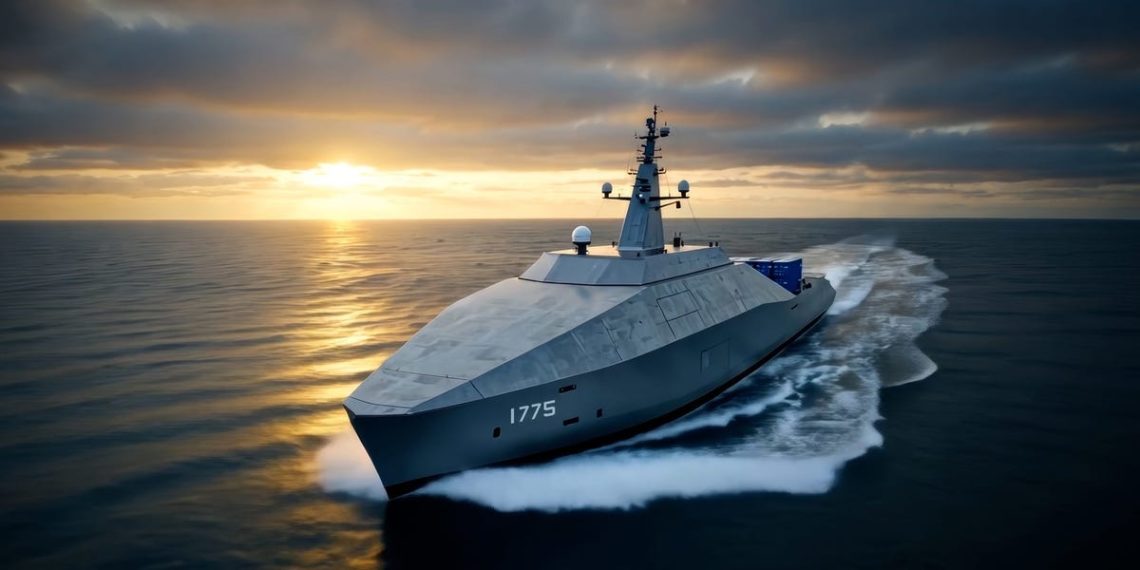
Blue Water Autonomy
- The US Navy is looking to acquire a fleet of long-range drone ships for a potential high-end fight.
- One American company is developing medium-sized vessels that can be used for different missions.
- Blue Water Autonomy has tested its technology on the water in a major step forward for the project.
As the US Navy prepares for the possibility of a war with China, a big challenge is finding enough of the right ships for the fight.
Long-range drone ships could transform Pacific warfare, expanding a navy’s reach while keeping sailors out of harm’s way. An American company building these kinds of ships with the Navy’s needs in mind says it has successfully tested its technology in the water, bringing the innovative vessel a major step closer to becoming reality.
Blue Water Autonomy is the first to test larger, long-range interchangeable ship-scale systems in an iterative way on the water, its leadership told Business Insider. The company aims to build a full-scale autonomous warship that could one day fight in a war with a major adversary, like China, in which naval drones may play a key role.
These kinds of uncrewed vessels could expand fleet size and coverage, a necessity in a Pacific fight stretching across vast swaths of water. They could also push into hotly contested waterways without putting human sailors at risk.
Naval warfare has become increasingly flooded with drone technology in recent years. From the Black Sea to the Red Sea, drone attacks are forcing militaries to rethink not only defense, but also how they can better modernize their fleets and integrate this cutting-edge technology into their traditional force structure.
The US Navy plans to build a battle force of 381 crewed warships and 134 uncrewed surface and undersea vessels. It already fields some drones — smaller surveillance platforms and combat systems — that are built by companies across the US defense industry.

Blue Water Autonomy
A key area of focus, though, is developing a fleet of larger, long-range drone ships to expand the Navy’s reach across the vast Pacific with the aim of countering China’s rapidly modernizing maritime force on the open seas. For Blue Water, this is where it believes its vessels could be handy.
The Boston-based startup launched in 2024 with the goal of building fully autonomous warships for a Pacific fight that can be mass-produced without putting any additional strain on America’s already struggling shipbuilding industry. These ships would operate alongside crewed vessels in combat.
Since its founding, Blue Water has been developing “ship-scale hardware” and “ship-focused software,” said Rylan Hamilton, the company’s CEO and a former US Navy engineer and surface warfare officer.
The company built an autonomous test vessel and has logged hundreds of hours of testing off the coast of Massachusetts over the past year, with a plan to launch a full-scale, 150-foot-long prototype in 2026.
Photos of the autonomous vessel, shared exclusively with Business Insider by Blue Water, show it being tested in the open ocean.
“On the hardware side, we’re super focused on reliability, because the last thing the US Navy needs is to basically have autonomous ships that are sort of dead in the water in the middle of the ocean,” Hamilton said.

propulsion testing hardware.
Blue Water Autonomy
Reliability is driven by propulsion technology, so there’s a focus on building a redundant engineering structure and testing that on the water.
On the software side, Blue Water is testing navigation autonomy that is similar, as Hamilton explained, to the technology that powers driverless Waymo cars in California, as well as the operating software that enables the ship to move from one point to another.
Blue Water is believed to be the only company testing and iterating with its technology on the water before actually building a ship, Hamilton said. The startup has a contract with the Navy to continue testing the technology and hopes to receive an order next year to build full-scale ships at a Louisiana shipyard.
One of the significant challenges for the US as it prepares for a potential conflict with China is building more warships in a shipbuilding industry that is bogged down by delays, cost overruns, and workforce problems. The Trump administration has taken some steps to remedy these issues, but reviving it could take years.
China already has a larger naval force than the US, and its shipyards far outpace America in the construction of new vessels. Navy officials have said that autonomous vessels could help fill some gaps, and they are easier and quicker to build than traditional crewed ships like destroyers, cruisers, or flattops.
Austin Gray, Blue Water’s co-founder and the company’s chief strategy officer, told Business Insider earlier this year that the company can make dozens of autonomous ships at smaller yet still fully equipped shipyards in a matter of months.

Blue Water Autonomy
Hamilton said that Blue Water is designing medium-sized, multi-mission ships with the endurance and payload needed for the vast, open waters of the Pacific. They will be expensive — at tens of millions of dollars apiece — yet still far cheaper than crewed ships, which can cost several billion each.
“Whether it’s carrying missiles or radars, these ships are large enough that they can operate across the open ocean and carry kind of the most impactful payloads that the Navy has right now to complement the main fleet,” Hamilton said.
The vessels are designed with enough range to sail from California to Taiwan and back — more than 6,000 miles — and are large enough to handle rough seas that would overwhelm smaller craft.
It’s a challenging task, and integrating drone technology into the US fleet is still a relatively new concept, especially for larger vessels. Building an autonomous vessel means having an engine room that can go unstaffed for hours on end without breaking down because, unlike on a traditional warship, there aren’t dozens of engineers who could react to a crisis.
“It’s kind of a big leap to actually make something without people,” Hamilton said. “We’re doing something that’s magnitudes harder than anything the Navy’s done so far.”
Read the original article on Business Insider
The post A US company making long-range drone warships for a China fight just put its tech to the test in the water appeared first on Business Insider.




